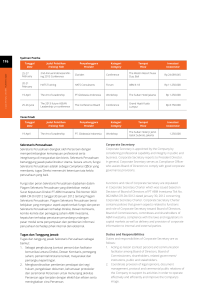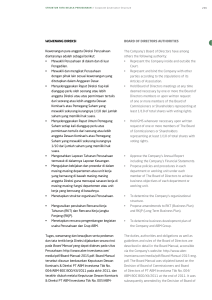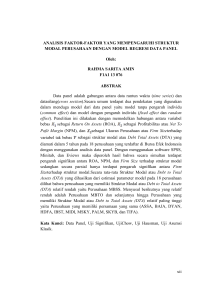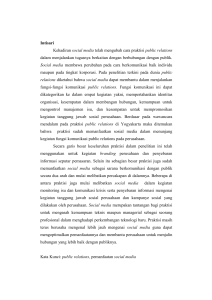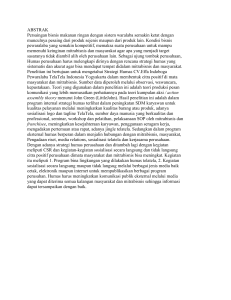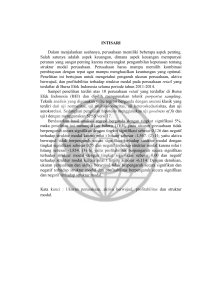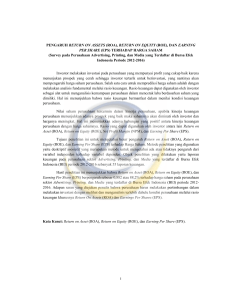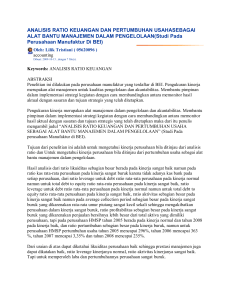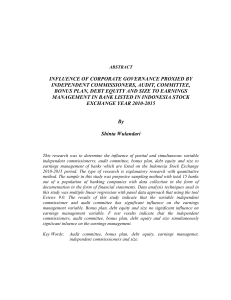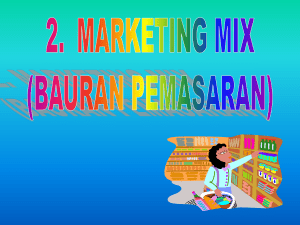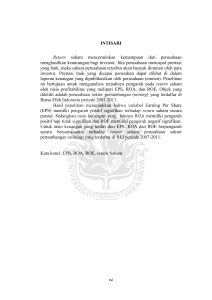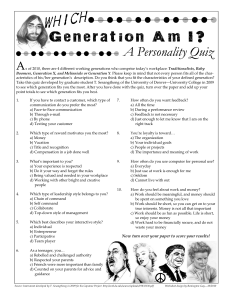DAFTAR PUSTAKA
advertisement
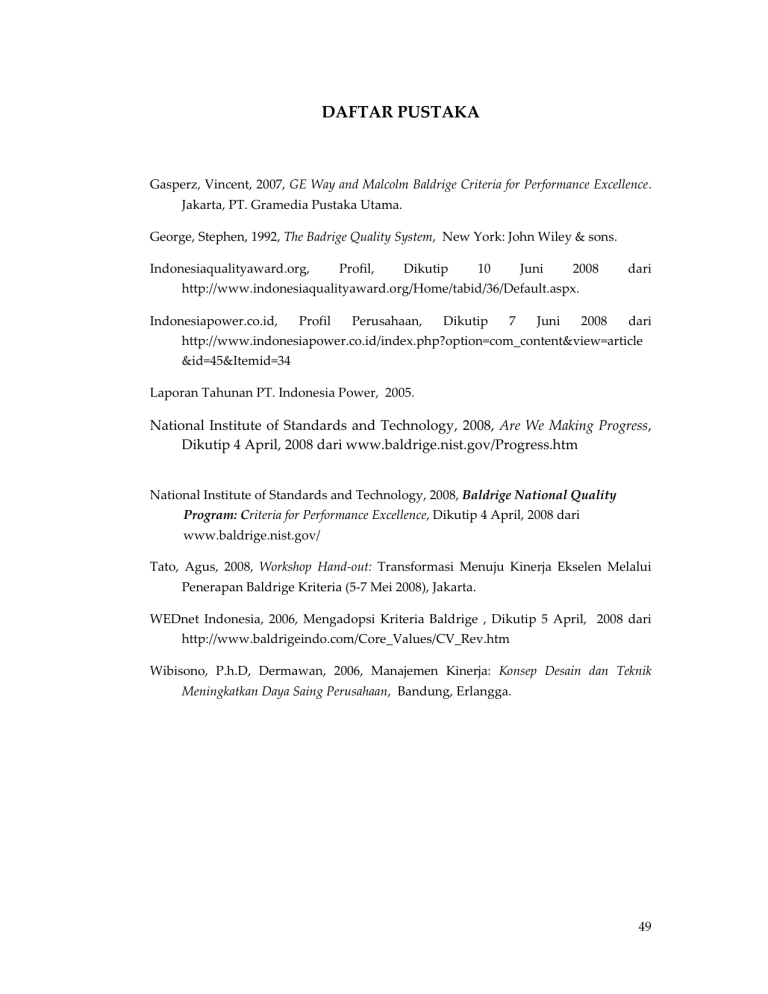
DAFTAR PUSTAKA Gasperz, Vincent, 2007, GE Way and Malcolm Baldrige Criteria for Performance Excellence. Jakarta, PT. Gramedia Pustaka Utama. George, Stephen, 1992, The Badrige Quality System, New York: John Wiley & sons. Indonesiaqualityaward.org, Profil, Dikutip 10 Juni 2008 dari http://www.indonesiaqualityaward.org/Home/tabid/36/Default.aspx. Indonesiapower.co.id, Profil Perusahaan, Dikutip 7 Juni 2008 dari http://www.indonesiapower.co.id/index.php?option=com_content&view=article &id=45&Itemid=34 Laporan Tahunan PT. Indonesia Power, 2005. National Institute of Standards and Technology, 2008, Are We Making Progress, Dikutip 4 April, 2008 dari www.baldrige.nist.gov/Progress.htm National Institute of Standards and Technology, 2008, Baldrige National Quality Program: Criteria for Performance Excellence, Dikutip 4 April, 2008 dari www.baldrige.nist.gov/ Tato, Agus, 2008, Workshop Hand-out: Transformasi Menuju Kinerja Ekselen Melalui Penerapan Baldrige Kriteria (5-7 Mei 2008), Jakarta. WEDnet Indonesia, 2006, Mengadopsi Kriteria Baldrige , Dikutip 5 April, 2008 dari http://www.baldrigeindo.com/Core_Values/CV_Rev.htm Wibisono, P.h.D, Dermawan, 2006, Manajemen Kinerja: Konsep Desain dan Teknik Meningkatkan Daya Saing Perusahaan, Bandung, Erlangga. 49 LAMPIRAN A. MBNQA 2008 question 2008 Baldrige National Quality Program Criteria for Performance Excellence 1 Leadership (120 pts.) The Leadership Category examines HOW your organization’s SENIOR LEADERS guide and sustain your organization. Also examined are your organization’s GOVERNANCE and HOW your organization addresses its ethical, legal, and community responsibilities. 1.1 Senior Leadership: How do your senior leaders lead? (70 pts.) Process Describe HOW SENIOR LEADERS guide and sustain your organization. Describe HOW SENIOR LEADERS communicate with your WORKFORCE and encourage HIGH PERFORMANCE. Within your response, include answers to the following questions: a. VISION and VALUES (1) HOW do SENIOR LEADERS set organizational VISION and VALUES? HOW do SENIOR LEADERS DEPLOY your organization’s VISION and VALUES through your LEADERSHIP SYSTEM, to the WORKFORCE, to KEY suppliers and PARTNERS, and to CUSTOMERS and other STAKEHOLDERS, as appropriate? HOW do SENIOR LEADERS’ personal actions reflect a commitment to the organization’s VALUES? (2) HOW do SENIOR LEADERS personally promote an organizational environment that fosters, requires, and results in legal and ETHICAL BEHAVIOR? (3) HOW do SENIOR LEADERS create a SUSTAINABLE organization? HOW do SENIOR LEADERS create an environment for organizational PERFORMANCE improvement, the accomplishment of your MISSION and STRATEGIC OBJECTIVES, INNOVATION, competitive or role-model PERFORMANCE leadership, and organizational agility? HOW do they create an environment for organizational and WORKFORCE LEARNING? HOW do they personally participate in succession planning and the development of future organizational leaders? b. Communication and Organizational PERFORMANCE (1) HOW do SENIOR LEADERS communicate with and engage the entire WORKFORCE? HOW do SENIOR LEADERS encourage frank, two-way communication throughout the organization? HOW do SENIOR LEADERS communicate KEY decisions? HOW do SENIOR LEADERS take an active role in reward and recognition programs to reinforce HIGH PERFORMANCE and a CUSTOMER and business focus? (2) HOW do SENIOR LEADERS create a focus on action to accomplish the organization’s objectives, improve PERFORMANCE, and attain its VISION? What PERFORMANCE MEASURES do SENIOR LEADERS regularly review to inform them on needed actions? HOW do SENIOR LEADERS include a focus on creating and balancing VALUE for CUSTOMERS and other STAKEHOLDERS in their organizational PERFORMANCE expectations? Notes: N1. Organizational vision (1.1a[1]) should set the context for strategic objectives and action plans, which are described in Items 2.1 and 2.2. N2. A sustainable organization (1.1a[3]) is capable of addressing current business needs and possesses the agility and strategic management to prepare successfully for its future business and market environment. In this context, the concept of innovation includes both technological and organizational innovation to succeed in the future. A sustainable organization also ensures a safe and secure environment for the workforce and other key stakeholders. N3. A focus on action (1.1b[2]) considers the workforce, the work systems, and the hard assets of your organization. It includes ongoing improvements in productivity that may be achieved through eliminating waste or reducing cycle time, and it might use techniques such as Six Sigma and Lean. It also includes the actions to accomplish your organization’s strategic objectives. N4. Your organizational performance results should be reported in Items 7.1–7.6. N5. For nonprofit organizations that rely on volunteers to accomplish their work, responses to 1.1b(1) also should discuss your efforts to communicate with and engage the volunteer workforce. For additional description of this Item, see page 35. 2008 Criteria for Performance Excellence 7 1.2 Governance and Social Responsibilities: How do you govern and address your social responsibilities? (50 pts.) Process Describe your organization’s GOVERNANCE system. Describe HOW your organization addresses its responsibilities to the public, ensures ETHICAL BEHAVIOR, and practices good citizenship. Within your response, include answers to the following questions: a. Organizational GOVERNANCE (1) HOW does your organization review and achieve the following KEY aspects of your GOVERNANCE system: • accountability for management’s actions • fiscal accountability • transparency in operations and selection of and disclosure policies for GOVERNANCE board members, as appropriate • independence in internal and external audits • protection of STAKEHOLDER and stockholder interests, as appropriate (2) HOW do you evaluate the PERFORMANCE of your SENIOR LEADERS, including the chief executive? HOW do you evaluate the PERFORMANCE of members of your GOVERNANCE board, as appropriate? HOW do SENIOR LEADERS and your GOVERNANCE board use these PERFORMANCE reviews to further develop and to improve both their personal leadership EFFECTIVENESS and that of your board and LEADERSHIP SYSTEM, as appropriate? b. Legal and ETHICAL BEHAVIOR (1) HOW do you address any adverse impacts on society of your products, services, and operations? HOW do you anticipate public concerns with current and future products, services, and operations? HOW do you prepare for these concerns in a proactive manner, including using resource-sustaining PROCESSES, as appropriate? What are your KEY compliance PROCESSES, MEASURES, and GOALS for achieving and surpassing regulatory and legal requirements, as appropriate? What are your KEY PROCESSES, MEASURES, and GOALS for addressing risks associated with your products, services, and operations? (2) HOW does your organization promote and ensure ETHICAL BEHAVIOR in all your interactions? What are your KEY PROCESSES and MEASURES or INDICATORS for enabling and monitoring ETHICAL BEHAVIOR in your GOVERNANCE structure, throughout your organization, and in interactions with CUSTOMERS, PARTNERS, and other STAKEHOLDERS? HOW do you monitor and respond to breaches of ETHICAL BEHAVIOR? c. Support of KEY Communities HOW does your organization actively support and strengthen your KEY communities? HOW do you identify KEY communities and determine areas of emphasis for organizational involvement and support? What are your KEY communities? HOW do your SENIOR LEADERS, in concert with your WORKFORCE, contribute to improving these communities? Notes: N1. Societal responsibilities in areas critical to your organization’s ongoing success also should be addressed in Strategy Development (Item 2.1) and in Process Management (Category 6). Key results, such as results of regulatory and legal compliance (including the results of mandated financial audits), environmental improvements through use of “green” technology or other means, or conservation activities, should be reported as Leadership Outcomes (Item 7.6). N2. Transparency in operations of your governance board (1.2a[1]) should include your internal controls on governance processes. For some nonprofit organizations, an external advisory board may provide some or all of the governance board functions. For those nonprofit organizations that 8 serve as stewards of public funds, stewardship of those funds and transparency in operations are areas of emphasis. N3. Leadership performance evaluation (1.2a[2]) might be supported by peer reviews, formal performance management reviews (5.1b), and formal or informal workforce and other stakeholder feedback and surveys. For some nonprofit and government organizations, external advisory boards might evaluate the performance of senior leaders and the governance board. N4. Measures or indicators of ethical behavior (1.2b[2]) might include the percentage of independent board members, measures of relationships with stockholder and nonstockholder constituencies, 2008 Criteria for Performance Excellence instances of ethical conduct breaches and responses, survey results on workforce perceptions of organizational ethics, ethics hotline use, and results of ethics reviews and audits. They also might include evidence that policies, workforce training, and monitoring systems are in place with respect to conflicts of interest and proper use of funds. N5. Areas of community support appropriate for inclusion in 1.2c might include your efforts to strengthen local community services, education, and health; the environment, including collaborative activities to conserve the environment or natural resources; and practices of trade, business, or professional associations. N6. The health and safety of your workforce are not addressed in Item 1.2; you should address these employee factors in Item 5.2. N7. Nonprofit organizations should report in 1.2b(1), as appropriate, how they address the legal and regulatory requirements and standards that govern fundraising and lobbying activities. N8. For some charitable organizations, support for key communities (1.2c) may occur totally through the missionrelated activities of the organization. In such cases, it is appropriate to respond with any “extra efforts” you devote to support of these communities. For additional description of this Item, see pages 35–36. Assessment of Item Responses Item responses are assessed by considering the Criteria Item requirements; your key business factors presented in your Organizational Profile; and the maturity of your approaches, breadth of their deployment, and strength of your improvement process and results relative to the Scoring System. Refer to the Scoring System information on pages 63–66. 2008 Criteria for Performance Excellence 9 2 Strategic Planning (85 pts.) The Strategic Planning Category examines HOW your organization develops STRATEGIC OBJECTIVES and ACTION PLANS. Also examined are HOW your chosen STRATEGIC OBJECTIVES and ACTION PLANS are DEPLOYED and changed if circumstances require, and HOW progress is measured. 2.1 Strategy Development: How do you develop your strategy? (40 pts.) Process Describe HOW your organization determines its STRATEGIC CHALLENGES and ADVANTAGES. Describe HOW your organization establishes its strategy and STRATEGIC OBJECTIVES to address these CHALLENGES and enhance its ADVANTAGES. Summarize your organization’s KEY STRATEGIC OBJECTIVES and their related GOALS. Within your response, include answers to the following questions: a. Strategy Development PROCESS (1) HOW does your organization conduct its strategic planning? What are the KEY PROCESS steps? Who are the KEY participants? HOW does your PROCESS identify potential blind spots? HOW do you determine your STRATEGIC CHALLENGES and ADVANTAGES, as identified in response to P.2 in your Organizational Profile? What are your short- and longer-term planning time horizons? HOW are these time horizons set? HOW does your strategic planning PROCESS address these time horizons? (2) HOW do you ensure that strategic planning addresses the KEY factors listed below? HOW do you collect and analyze relevant data and information pertaining to these factors as part of your strategic planning PROCESS: • your organization’s strengths, weaknesses, opportunities, and threats • early indications of major shifts in technology, markets, CUSTOMER preferences, competition, or the regulatory environment • long-term organizational SUSTAINABILITY • your ability to execute the strategic plan b. STRATEGIC OBJECTIVES (1) What are your KEY STRATEGIC OBJECTIVES and your timetable for accomplishing them? What are your most important GOALS for these STRATEGIC OBJECTIVES? (2) HOW do your STRATEGIC OBJECTIVES address your STRATEGIC CHALLENGES and STRATEGIC ADVANTAGES? HOW do your STRATEGIC OBJECTIVES address your opportunities for INNOVATION in products and services, operations, and the business model? HOW do you ensure that your STRATEGIC OBJECTIVES balance short- and longer-term challenges and opportunities? HOW do you ensure that your STRATEGIC OBJECTIVES balance the needs of all KEY STAKEHOLDERS? Notes: N1. “Strategy development” refers to your organization’s approach (formal or informal) to preparing for the future. Strategy development might utilize various types of forecasts, projections, options, scenarios, knowledge (see 4.2b for relevant organizational knowledge), or other approaches to envisioning the future for purposes of decision making and resource allocation. Strategy development might involve participation by key suppliers, distributors, partners, and customers. For some nonprofit organizations, strategy development might involve participation by organizations providing similar services or drawing from the same donor population or volunteer workforce. N2. “Strategy” should be interpreted broadly. Strategy might be built around or lead to any or all of the following: new products, services, and markets; revenue 10 growth via various approaches, including acquisitions, grants, and endowments; divestitures; new partnerships and alliances; and new employee or volunteer relationships. Strategy might be directed toward becoming a preferred supplier, a local supplier in each of your major customers’ or partners’ markets, a low-cost producer, a market innovator, or a high-end or customized product or service provider. It also might be directed toward meeting a community or public need. N3. Your organization’s strengths, weaknesses, opportunities, and threats (2.1a[2]) should address all factors that are key to your organization’s future success, including the following, as appropriate: your customer and market needs, expectations, and opportunities; your opportunities for innovation and role-model performance; your core competencies; your competitive 2008 Criteria for Performance Excellence environment and your performance relative to competitors and comparable organizations; your product life cycle; technological and other key innovations or changes that might affect your products and services and how you operate, as well as the rate of that innovation; your human and other resource needs; your ability to capitalize on diversity; your opportunities to redirect resources to higher-priority products, services, or areas; financial, societal, ethical, regulatory, technological, security, and other potential risks; your ability to prevent and respond to emergencies, including natural or other disasters; changes in the national or global economy; partner and supply chain needs, strengths, and weaknesses; changes in your parent organization; and other factors unique to your organization. N4. Your ability to execute the strategic plan (2.1a[2]) should address your ability to mobilize the necessary resources and knowledge. It also should address your organizational agility based on contingency plans or if circumstances require a shift in plans and rapid execution of new or changed plans. N5. Strategic objectives that address key challenges and advantages (2.1b[2]) might include rapid response, customization, co-location with major customers or partners, workforce capability and capacity, specific joint ventures, virtual manufacturing, rapid innovation, ISO 9000:2000 or ISO 14000 registration, Web-based supplier and customer relationship management, and product and service quality enhancements. Responses to Item 2.1 should focus on your specific challenges and advantages—those most important to your ongoing success and to strengthening your organization’s overall performance. N6. Item 2.1 addresses your overall organizational strategy, which might include changes in services, products, and product lines. However, the Item does not address product or service design; you should address these factors in Item 6.1, as appropriate. For additional description of this Item, see page 37. 2.2 Strategy Deployment: How do you deploy your strategy? (45 pts.) Process Describe HOW your organization converts its STRATEGIC OBJECTIVES into ACTION PLANS. Summarize your organization’s ACTION PLANS and related KEY PERFORMANCE MEASURES or INDICATORS. Project your organization’s future PERFORMANCE relative to KEY comparisons on these PERFORMANCE MEASURES or INDICATORS. Within your response, include answers to the following questions: a. ACTION PLAN Development and DEPLOYMENT (1) HOW do you develop and DEPLOY ACTION PLANS throughout the organization to achieve your KEY STRATEGIC OBJECTIVES? HOW do you ensure that the KEY outcomes of your ACTION PLANS can be sustained? (2) HOW do you ensure that adequate financial and other resources are available to support the accomplishment of your ACTION PLANS? HOW do you allocate these resources to support the accomplishment of the plans? HOW do you assess the financial and other risks associated with the plans? HOW do you balance resources to ensure adequate resources to meet current obligations? (3) HOW do you establish and DEPLOY modified ACTION PLANS if circumstances require a shift in plans and rapid execution of new plans? (4) What are your KEY short- and longer-term ACTION PLANS? What are the KEY planned changes, if any, in your products and services, your CUSTOMERS and markets, and how you will operate? (5) What are your KEY human resource plans to accomplish your short- and longer-term STRATEGIC OBJECTIVES and ACTION PLANS? HOW do the plans address potential impacts on people in your WORKFORCE and any potential changes to WORKFORCE CAPABILITY and CAPACITY needs? (6) What are your KEY PERFORMANCE MEASURES or INDICATORS for tracking progress on your ACTION PLANS? HOW do you ensure that your overall ACTION PLAN measurement system reinforces organizational ALIGNMENT? HOW do you ensure that the measurement system covers all KEY DEPLOYMENT areas and STAKEHOLDERS? b. PERFORMANCE PROJECTION For the KEY PERFORMANCE MEASURES or INDICATORS identified in 2.2a(6), what are your PERFORMANCE PROJECTIONS for both your short- and longer-term planning time horizons? HOW are these PROJECTIONS determined? How does your projected PERFORMANCE compare with the projected PERFORMANCE of your competitors or comparable organizations? How does it compare with KEY BENCHMARKS, GOALS, and past PERFORMANCE, as appropriate? HOW do you ensure progress so that you will meet your PROJECTIONS? If there are current or projected gaps in PERFORMANCE against your competitors or comparable organizations, HOW will you address them? 2008 Criteria for Performance Excellence 11 Notes: N1. Strategy and action plan development and deployment are closely linked to other Items in the Criteria. The following are examples of key linkages: • Item 1.1 for how your senior leaders set and communicate organizational direction; • Category 3 for gathering customer and market knowledge as input to your strategy and action plans and for deploying action plans; • Category 4 for measurement, analysis, and knowledge management to support your key information needs, to support your development of strategy, to provide an effective basis for your performance measurements, and to track progress relative to your strategic objectives and action plans; • Category 5 for meeting your workforce capability and capacity needs, for workforce development and learning system design and needs, and for implementing workforce-related changes resulting from action plans; • Category 6 for changes to work systems and work process requirements resulting from your action plans; and • Item 7.6 for specific accomplishments relative to your organizational strategy and action plans. N2. Deployment of action plans (2.2a[1]) might include key partners, collaborators, and suppliers. N3. Measures and indicators of projected performance (2.2b) might include changes resulting from new ventures; organizational acquisitions or mergers; new value creation; market entry and shifts; new legislative mandates, legal requirements, or industry standards; and significant anticipated innovations in products, services, and technology. For additional description of this Item, see pages 37–38. 12 2008 Criteria for Performance Excellence 3 Customer and Market Focus (85 pts.) The CUSTOMER and Market Focus Category examines HOW your organization determines the requirements, needs, expectations, and preferences of CUSTOMERS and markets. Also examined is HOW your organization builds relationships with CUSTOMERS and determines the KEY factors that lead to CUSTOMER acquisition, satisfaction, loyalty, and retention and to business expansion and SUSTAINABILITY. 3.1 Customer and Market Knowledge: How do you obtain and use customer and market knowledge? (40 pts.) Process Describe HOW your organization determines requirements, needs, expectations, and preferences of CUSTOMERS and markets to ensure the continuing relevance of your products and services and to develop new business opportunities. Within your response, include answers to the following questions: a. CUSTOMER and Market Knowledge (1) HOW do you identify CUSTOMERS, CUSTOMER groups, and market SEGMENTS? HOW do you determine which CUSTOMERS, CUSTOMER groups, and market SEGMENTS to pursue for current and future products and services? HOW do you include CUSTOMERS of competitors and other potential CUSTOMERS and markets in this determination? (2) HOW do you use the voice of the CUSTOMER to determine KEY CUSTOMER requirements, needs, and changing expectations (including product and service features) and their relative importance to CUSTOMERS’ purchasing or relationship decisions? How do your listening methods vary for different CUSTOMERS, CUSTOMER groups, or market SEGMENTS? HOW do you use relevant information and feedback from current and former CUSTOMERS, including marketing and sales information, CUSTOMER loyalty and retention data, CUSTOMER referrals, win/loss ANALYSIS, and complaint data for PURPOSES of planning products and services, marketing, making WORK SYSTEM and work PROCESS improvements, and developing new business opportunities? (3) HOW do you use voice-of-the-CUSTOMER information and feedback to become more CUSTOMER-focused, to better satisfy CUSTOMER needs and desires, and to identify opportunities for INNOVATION? (4) HOW do you keep your CUSTOMER and market listening and LEARNING methods current with business needs and directions, including changes in your marketplace? Notes: N1. Your responses to this Item should include the customer groups and market segments identified in P.1b(2). N2. If your products and services are sold or delivered to end-use customers via other businesses or organizations (e.g., those that are part of your “value chain,” such as retail stores, dealers, or local distributors), customer groups (3.1a[1]) should include both the end users and these intermediate organizations. N3. The “voice of the customer” (3.1a[2]) is your process for capturing customer-related information. Voice-of-the-customer processes are intended to be proactive and continuously innovative to capture stated, unstated, and anticipated customer requirements, needs, and desires. The goal is to achieve customer loyalty and build customer relationships, as appropriate. The voice of the customer might include gathering and integrating survey data, focus group 2008 Criteria for Performance Excellence findings, Web-based data, warranty data, complaint logs and field reports, and other data and information that affect customers’ purchasing and relationship decisions. N4. “Product and service features” (3.1a[2]) refers to all the important characteristics of products and services and to their performance throughout their full life cycle and the full “consumption chain.” This includes all customers’ purchasing and interaction experiences with your organization that influence purchasing and relationship decisions. The focus should be on features that affect customer preference and loyalty— for example, those features that differentiate your products and services from competing offerings or other organizations’ services. Those features might include price, reliability, value, delivery, timeliness, ease of use, requirements for hazardous materials use and disposal, customer or technical support, and the sales 13 relationship. Key product and service features and purchasing and relationship decisions (3.1a[2]) might take into account how transactions occur and factors such as confidentiality and security. Your results on performance relative to key product and service features should be reported in Item 7.1, and those concerning customer perceptions and actions (outcomes) should be reported in Item 7.2. N5. For additional considerations on products, services, customers, and the business of nonprofit organizations, see Item P.1, Notes 6 and 7, and Item P.2, Note 5. For additional description of this Item, see page 38. 3.2 Customer Relationships and Satisfaction: How do you build relationships and grow customer satisfaction and loyalty? (45 pts.) Process Describe HOW your organization builds relationships to acquire, satisfy, and retain CUSTOMERS and to increase Describe also HOW your organization determines CUSTOMER satisfaction and dissatisfaction. CUSTOMER loyalty. Within your response, include answers to the following questions: a. CUSTOMER Relationship Building (1) HOW do you build relationships to acquire CUSTOMERS, to meet and exceed their expectations, to increase loyalty and repeat business, and to gain positive referrals? (2) HOW do your KEY access mechanisms enable CUSTOMERS to seek information, conduct business, and make complaints? What are your KEY access mechanisms? HOW do you determine KEY CUSTOMER contact requirements for each mode of CUSTOMER access? HOW do you ensure that these contact requirements are DEPLOYED to all people and PROCESSES involved in the CUSTOMER response chain? (3) HOW do you manage CUSTOMER complaints? HOW do you ensure that complaints are resolved EFFECTIVELY and promptly? HOW do you minimize CUSTOMER dissatisfaction and, as appropriate, loss of repeat business and referrals? HOW are complaints aggregated and analyzed for use in improvement throughout your organization and by your PARTNERS? (4) HOW do you keep your APPROACHES to building relationships and providing CUSTOMER access current with business needs and directions? b. CUSTOMER Satisfaction Determination (1) HOW do you determine CUSTOMER satisfaction, dissatisfaction, and loyalty? How do these determination methods differ among CUSTOMER groups? HOW do you ensure that your measurements capture actionable information for use in exceeding your CUSTOMERS’ expectations? HOW do you ensure that your measurements capture actionable information for use in securing your CUSTOMERS’ future business and gaining positive referrals, as appropriate? HOW do you use CUSTOMER satisfaction and dissatisfaction information for improvement? (2) HOW do you follow up with CUSTOMERS on the quality of products, services, and transactions to receive prompt and actionable feedback? (3) HOW do you obtain and use information on your CUSTOMERS’ satisfaction relative to their satisfaction with your competitors? HOW do you obtain and use information on your CUSTOMERS’ satisfaction relative to the CUSTOMER satisfaction LEVELS of other organizations providing similar products or services, and/or industry BENCHMARKS? (4) HOW do you keep your APPROACHES to determining satisfaction current with business needs and directions? Notes: N1. Customer relationship building (3.2a) might include the development of partnerships or alliances with customers. N2. Determining customer satisfaction and dissatisfaction (3.2b) might include the use of any or all of the following: surveys, formal and informal feedback, 14 customer account histories, complaints, win/loss analysis, and transaction completion rates. Information might be gathered on the Web, through personal contact or a third party, or by mail. N3. Customer satisfaction and dissatisfaction measurements (3.2b[1]) might include both a numerical 2008 Criteria for Performance Excellence rating scale and descriptors for each unit in the scale. Actionable customer satisfaction measurements provide useful information about specific product and service features, delivery, relationships, and transactions that affect customers’ future actions—repeat business and positive referrals. N4. Other organizations providing similar products or services (3.2b[3]) might include organizations that are not competitors but provide similar products and services in other geographic areas or to different populations of people. N5. Your customer satisfaction and dissatisfaction results should be reported in Item 7.2. N6. For some nonprofit organizations (e.g., some government agencies or charitable organizations), customers may be assigned or may be required to use your organization, and relationships may be short-term. For those organizations, relationship building (3.2a[1]) might be focused on meeting and exceeding expectations during the short-term relationship, resulting in positive comments to other people, including key stakeholders of your organization. For additional description of this Item, see page 39. 2008 Criteria for Performance Excellence 15 Measurement, Analysis, and 4 Knowledge Management (90 pts.) The Measurement, ANALYSIS , and Knowledge Management Category examines HOW your organization selects, gathers, analyzes, manages, and improves its data, information, and KNOWLEDGE ASSETS and HOW it manages its information technology. The Category also examines HOW your organization reviews and uses reviews to improve its PERFORMANCE. 4.1 Measurement, Analysis, and Improvement of Organizational Performance: How do you measure, analyze, and then improve organizational performance? (45 pts.) Process Describe HOW your organization measures, analyzes, aligns, reviews, and improves its PERFORMANCE through the use of data and information at all levels and in all parts of your organization. Describe HOW you SYSTEMATICALLY use the results of reviews to evaluate and improve PROCESSES. Within your response, include answers to the following questions: a. PERFORMANCE Measurement (1) HOW do you select, collect, align, and integrate data and information for tracking daily operations and for tracking overall organizational PERFORMANCE, including progress relative to STRATEGIC OBJECTIVES and ACTION PLANS? What are your KEY organizational PERFORMANCE MEASURES, including KEY short-term and longerterm financial MEASURES? HOW do you use these data and information to support organizational decision making and INNOVATION? (2) HOW do you select and ensure the EFFECTIVE use of KEY comparative data and information to support operational and strategic decision making and INNOVATION? (3) HOW do you keep your PERFORMANCE measurement system current with business needs and directions? HOW do you ensure that your PERFORMANCE measurement system is sensitive to rapid or unexpected organizational or external changes? b. PERFORMANCE ANALYSIS, Review, and Improvement (1) HOW do you review organizational PERFORMANCE and capabilities? What ANALYSES do you perform to support these reviews and to ensure that conclusions are valid? HOW do you use these reviews to assess organizational success, competitive PERFORMANCE, and progress relative to STRATEGIC OBJECTIVES and ACTION PLANS? HOW do you use these reviews to assess your organization’s ability to respond rapidly to changing organizational needs and challenges in your operating environment? (2) HOW do you translate organizational PERFORMANCE review findings into priorities for continuous and breakthrough improvement and into opportunities for INNOVATION? HOW are these priorities and opportunities DEPLOYED to work group and functional-level operations throughout your organization to enable EFFECTIVE support for their decision making? When appropriate, HOW are the priorities and opportunities DEPLOYED to your suppliers, PARTNERS, and COLLABORATORS to ensure organizational ALIGNMENT? (3) HOW do you incorporate the results of organizational PERFORMANCE reviews into the SYSTEMATIC evaluation and improvement of KEY PROCESSES? Notes: 16 N1. Performance measurement (4.1a) is used in factbased decision making for setting and aligning organizational directions and resource use at the work unit, key process, departmental, and whole organization levels. performance for similar activities, inside or outside your organization’s industry. Competitive comparisons relate your organization’s performance to that of competitors and other organizations providing similar products and services. N2. Comparative data and information (4.1a[2]) are obtained by benchmarking and by seeking competitive comparisons. “Benchmarking” refers to identifying processes and results that represent best practices and N3. Organizational performance reviews (4.1b[1]) should be informed by organizational performance measurement, performance measures reported throughout your Criteria Item responses, and performance measures reviewed by 2008 Criteria for Performance Excellence senior leaders (1.1b[2]), and they should be guided by the strategic objectives and action plans described in Items 2.1 and 2.2. The reviews also might be informed by internal or external Baldrige assessments. N4. Analysis (4.1b[1]) includes examining trends; organizational, industry, and technology projections; and comparisons, cause-effect relationships, and correlations. Analysis should support your performance reviews, help determine root causes, and help set priorities for resource use. Accordingly, analysis draws on all types of data: customer-related, financial and market, operational, and competitive. N5. The results of organizational performance analysis and review should contribute to your organizational strategic planning in Category 2. N6. Your organizational performance results should be reported in Items 7.1–7.6. For additional description of this Item, see pages 39–41. 4.2 Management of Information, Information Technology, and Knowledge: How do you manage your information, information technology, and organizational knowledge? (45 pts.) Process Describe HOW your organization ensures the quality and availability of needed data, information, software, and hardware for your WORKFORCE, suppliers, PARTNERS, COLLABORATORS, and CUSTOMERS. Describe HOW your organization builds and manages its KNOWLEDGE ASSETS. Within your response, include answers to the following questions: a. Management of Information Resources (1) HOW do you make needed data and information available? HOW do you make them accessible to your WORKFORCE, suppliers, PARTNERS, COLLABORATORS, and CUSTOMERS, as appropriate? (2) HOW do you ensure that hardware and software are reliable, secure, and user-friendly? (3) In the event of an emergency, HOW do you ensure the continued availability of hardware and software systems and the continued availability of data and information? (4) HOW do you keep your data and information availability mechanisms, including your software and hardware systems, current with business needs and directions and with technological changes in your operating environment? b. Data, Information, and Knowledge Management (1) HOW do you ensure the following properties of your organizational data, information, and knowledge: • accuracy • integrity and reliability • timeliness • security and confidentiality (2) HOW do you manage organizational knowledge to accomplish the following: • the collection and transfer of WORKFORCE knowledge • the transfer of relevant knowledge from and to CUSTOMERS, suppliers, PARTNERS, and COLLABORATORS • the rapid identification, sharing, and implementation of best practices • the assembly and transfer of relevant knowledge for use in your strategic planning PROCESS Note: N1. Data and information access (4.2a[1]) might be via electronic or other means. For additional description of this Item, see page 41. 2008 Criteria for Performance Excellence 17 5 Workforce Focus (85 pts.) The WORKFORCE Focus Category examines HOW your organization engages, manages, and develops your WORKFORCE to utilize its full potential in ALIGNMENT with your organization’s overall MISSION, strategy, and ACTION PLANS. The Category examines your ability to assess WORKFORCE CAPABILITY and CAPACITY needs and to build a WORKFORCE environment conducive to HIGH PERFORMANCE. 5.1 Workforce Engagement: How do you engage your workforce to achieve organizational and personal success? (45 pts.) Process Describe HOW your organization engages, compensates, and rewards your WORKFORCE to achieve HIGH Describe HOW members of your WORKFORCE, including leaders, are developed to achieve HIGH PERFORMANCE. Describe HOW you assess WORKFORCE ENGAGEMENT and use the results to achieve higher PERFORMANCE. PERFORMANCE. Within your response, include answers to the following questions: a. WORKFORCE Enrichment (1) HOW do you determine the KEY factors that affect WORKFORCE ENGAGEMENT? HOW do you determine the KEY factors that affect WORKFORCE satisfaction? HOW are these factors determined for different WORKFORCE groups and SEGMENTS? (2) HOW do you foster an organizational culture conducive to HIGH PERFORMANCE and a motivated WORKFORCE to accomplish the following: • cooperation, EFFECTIVE communication, and skill sharing within and across work units, operating units, and locations, as appropriate • EFFECTIVE information flow and two-way communication with supervisors and managers • individual goal setting, EMPOWERMENT, and initiative • INNOVATION in the work environment • the ability to benefit from the diverse ideas, cultures, and thinking of your WORKFORCE (3) HOW does your WORKFORCE PERFORMANCE management system support HIGH-PERFORMANCE WORK and WORKFORCE ENGAGEMENT? HOW does your WORKFORCE PERFORMANCE management system consider WORKFORCE compensation, reward, recognition, and incentive practices? HOW does your WORKFORCE PERFORMANCE management system reinforce a CUSTOMER and business focus and achievement of your ACTION PLANS? b. WORKFORCE and Leader Development (1) HOW does your WORKFORCE development and LEARNING system address the following: • needs and desires for LEARNING and development identified by your WORKFORCE, including supervisors and managers • your CORE COMPETENCIES, STRATEGIC CHALLENGES, and accomplishment of your ACTION PLANS, both short-term and long-term • organizational PERFORMANCE improvement, technological change, and INNOVATION • the breadth of development opportunities, including education, training, coaching, mentoring, and work-related experiences, as appropriate • the transfer of knowledge from departing or retiring workers • the reinforcement of new knowledge and skills on the job (2) HOW does your development and LEARNING system for leaders address the following: • development of personal leadership attributes • development of organizational knowledge • ethical business practices • your CORE COMPETENCIES, STRATEGIC CHALLENGES, and accomplishment of your ACTION PLANS, both short-term and long-term 18 2008 Criteria for Performance Excellence • organizational PERFORMANCE improvement, change, and INNOVATION • the breadth of leadership development opportunities, including education, training, coaching, mentoring, and work-related experiences, as appropriate (3) HOW do you evaluate the EFFECTIVENESS of your WORKFORCE and leader development and LEARNING systems? (4) HOW do you manage EFFECTIVE career progression for your entire WORKFORCE? HOW do you accomplish EFFECTIVE succession planning for management and leadership positions? c. Assessment of WORKFORCE ENGAGEMENT (1) HOW do you assess WORKFORCE ENGAGEMENT? What formal and informal assessment methods and MEASURES do you use to determine WORKFORCE ENGAGEMENT and WORKFORCE satisfaction? How do these methods and MEASURES differ across WORKFORCE groups and SEGMENTS? HOW do you use other INDICATORS, such as WORKFORCE retention, absenteeism, grievances, safety, and PRODUCTIVITY to assess and improve WORKFORCE ENGAGEMENT? (2) HOW do you relate assessment findings to KEY business RESULTS reported in Category 7 to identify opportunities for improvement in both WORKFORCE ENGAGEMENT and business RESULTS? Notes: N1. “Workforce” refers to the people actively involved in accomplishing the work of your organization. It includes your organization’s permanent, temporary, and part-time personnel, as well as any contract employees supervised by your organization. It includes team leaders, supervisors, and managers at all levels. People supervised by a contractor should be addressed in Category 6 as part of your larger work systems. For nonprofit organizations that also rely on volunteers,“workforce” includes these volunteers. N2. “Workforce engagement” refers to the extent of workforce commitment, both emotional and intellectual, to accomplishing the work, mission, and vision of the organization. Organizations with high levels of workforce engagement are often characterized by high-performing work environments in which people are motivated to do their utmost for the benefit of their customers and for the success of the organization. N3. Compensation, recognition, and related reward and incentive practices (5.1a[3]) include promotions and bonuses that might be based on performance, skills acquired, and other factors. In some government organizations, compensation systems are set by law or regulation. However, since recognition can include monetary and nonmonetary, formal and informal, and individual and group mechanisms, reward and recognition systems do permit flexibility. N4. Your organization may have unique considerations relative to workforce development, learning, and career progression. If this is the case, your response to 5.1b should include how you address these considerations. N5. Identifying improvement opportunities (5.1c[2]) might draw on your workforce-focused results presented in Item 7.4 and might involve addressing workforce-related problems based on their impact on your business results reported in response to other Category 7 Items. For additional description of this Item, see pages 42–43. 2008 Criteria for Performance Excellence 19 5.2 Workforce Environment: How do you build an effective and supportive workforce environment? (40 pts.) Process Describe HOW your organization manages WORKFORCE CAPABILITY and CAPACITY to accomplish the work of the organization. Describe HOW your organization maintains a safe, secure, and supportive work climate. Within your response, include answers to the following questions: a. WORKFORCE CAPABILITY and CAPACITY (1) HOW do you assess your WORKFORCE CAPABILITY and CAPACITY needs, including skills, competencies, and staffing levels? (2) HOW do you recruit, hire, place, and retain new employees? HOW do you ensure your WORKFORCE represents the diverse ideas, cultures, and thinking of your hiring community? (3) HOW do you manage and organize your WORKFORCE to accomplish the work of your organization, capitalize on the organization’s CORE COMPETENCIES, reinforce a CUSTOMER and business focus, exceed PERFORMANCE expectations, address your STRATEGIC CHALLENGES and ACTION PLANS, and achieve the agility to address changing business needs? (4) HOW do you prepare your WORKFORCE for changing CAPABILITY and CAPACITY needs? HOW do you manage your WORKFORCE, its needs, and your needs to ensure continuity, to prevent WORKFORCE reductions, and to minimize the impact of WORKFORCE reductions, if they do become necessary? b. WORKFORCE Climate (1) HOW do you ensure and improve workplace health, safety, and security? What are your PERFORMANCE MEASURES and improvement GOALS for each of these workplace factors? What are any significant differences in these factors and PERFORMANCE MEASURES or targets for different workplace environments? (2) HOW do you support your WORKFORCE via policies, services, and benefits? HOW are these tailored to the needs of a diverse WORKFORCE and different WORKFORCE groups and SEGMENTS? Notes: N1. “Workforce capability” refers to your organization’s ability to accomplish its work processes through the knowledge, skills, abilities, and competencies of its people. Capability may include the ability to build and sustain relationships with your customers; to innovate and transition to new technologies; to develop new products, services, and work processes; and to meet changing business, market, and regulatory demands. “Workforce capacity” refers to your organization’s ability to ensure sufficient staffing levels to accomplish its work processes and successfully deliver your products and services to your customers, including the ability to meet seasonal or varying demand levels. N2. Workforce capability and capacity should consider not only current needs but also future requirements based on your strategic objectives and action plans reported in Category 2. N3. Preparing your workforce for changing capability and capacity needs (5.2a[4]) might include training, education, frequent communication, considerations of workforce employment and employability, career counseling, and outplacement and other services. For additional description of this Item, see page 43. 20 2008 Criteria for Performance Excellence 6 Process Management (85 pts.) The PROCESS Management Category examines HOW your organization determines its CORE COMPETENCIES and WORK SYSTEMS and HOW it designs, manages, and improves its KEY PROCESSES for implementing those WORK SYSTEMS to deliver CUSTOMER VALUE and achieve organizational success and SUSTAINABILITY. Also examined is your readiness for emergencies. 6.1 Work Systems Design: How do you design your work systems? (35 pts.) Process Describe HOW your organization determines its CORE COMPETENCIES and designs its WORK SYSTEMS and KEY to deliver CUSTOMER VALUE, prepare for potential emergencies, and achieve organizational success and SUSTAINABILITY. PROCESSES Within your response, include answers to the following questions: a. CORE COMPETENCIES (1) HOW does your organization determine its CORE COMPETENCIES? What are your organization’s CORE COMPETENCIES, and how do they relate to your MISSION, competitive environment, and ACTION PLANS? (2) HOW do you design and innovate your overall WORK SYSTEMS? HOW do you decide which PROCESSES within your overall WORK SYSTEMS will be internal to your organization (your KEY work PROCESSES) and which will use external resources? b. Work PROCESS Design (1) What are your organization’s KEY work PROCESSES? How do these KEY work PROCESSES relate to your CORE COMPETENCIES? How do these PROCESSES contribute to delivering CUSTOMER VALUE, profitability, organizational success, and SUSTAINABILITY? (2) HOW do you determine KEY work PROCESS requirements, incorporating input from CUSTOMERS, suppliers, PARTNERS, and COLLABORATORS, as appropriate? What are the KEY requirements for these PROCESSES? (3) HOW do you design and innovate your work PROCESSES to meet all the KEY requirements? HOW do you incorporate new technology, organizational knowledge, and the potential need for agility into the design of these PROCESSES? HOW do you incorporate CYCLE TIME, PRODUCTIVITY, cost control, and other efficiency and EFFECTIVENESS factors into the design of these PROCESSES? c. Emergency Readiness HOW do you ensure WORK SYSTEM and workplace preparedness for disasters or emergencies? HOW does your disaster and emergency preparedness system consider prevention, management, continuity of operations, and recovery? Notes: N1. “Core competencies” (6.1a) refers to your organization’s areas of greatest expertise. Your organization’s core competencies are those strategically important capabilities that provide an advantage in your marketplace or service environment. Core competencies frequently are challenging for competitors or suppliers and partners to imitate and provide a sustainable competitive advantage. N2. “Work systems” refers to how the work of your organization is accomplished. Work systems involve your workforce, your key suppliers and partners, your contractors, your collaborators, and other components of the supply chain needed to produce and deliver your products, services, and business and support processes. Your work systems coordinate the internal work processes and the external resources necessary for you to develop, produce, and deliver your products and services to your customers and to succeed in your marketplace. N3. Your key work processes (6.1b[1]) are the processes that involve the majority of your organization’s workforce and produce customer, stakeholder, and stockholder value. Your key work processes are your most important product and service design and delivery, business, and support processes. N4. Disasters and emergencies (6.1c) might be weather-related, utility-related, security-related, or due to a local or national emergency, including potential pandemics such as an avian flu outbreak. Emergency considerations related to information technology should be addressed in Item 4.2. For additional description of this Item, see pages 43–44. 2008 Criteria for Performance Excellence 21 6.2 Work Process Management and Improvement: How do you manage and improve your key organizational work processes? (50 pts.) Process Describe HOW your organization implements, manages, and improves its KEY work PROCESSES to deliver and achieve organizational success and SUSTAINABILITY. CUSTOMER VALUE Within your response, include answers to the following questions: a. Work PROCESS Management (1) HOW do you implement your work PROCESSES to ensure that they meet design requirements? HOW does your subsequent day-to-day operation of these PROCESSES ensure that they meet KEY PROCESS requirements? HOW is CUSTOMER, supplier, PARTNER, and COLLABORATOR input used in managing these PROCESSES, as appropriate? What are your KEY PERFORMANCE MEASURES or INDICATORS and in-process MEASURES used for the control and improvement of your work PROCESSES? (2) HOW do you minimize overall costs associated with inspections, tests, and PROCESS or PERFORMANCE audits, as appropriate? HOW do you prevent defects, service errors, and rework and minimize warranty costs or CUSTOMERS’ PRODUCTIVITY losses, as appropriate? b. Work PROCESS Improvement HOW do you improve your work PROCESSES to achieve better PERFORMANCE, to reduce variability, to improve products and services, and to keep the PROCESSES current with business needs and directions? HOW are improvements and lessons learned shared with other organizational units and PROCESSES to drive organizational LEARNING and INNOVATION? Notes: N1. To improve process performance (6.2b) and reduce variability, you might implement approaches such as a Lean Enterprise System, Six Sigma methodology, use of ISO 9000:2000 standards, the Plan-Do-CheckAct methodology, or other process improvement tools. N2. The results of improvements in product and service performance should be reported in Item 7.1. All other work process performance results should be reported in Item 7.5. For additional description of this Item, see pages 44–45. 22 2008 Criteria for Performance Excellence 7 Results (450 pts.) The R Results ESULTS Category examines your organization’s PERFORMANCE and improvement in all KEY areas—product and service outcomes, CUSTOMER-focused outcomes, financial and market outcomes, WORKFORCE-focused outcomes, PROCESS-EFFECTIVENESS outcomes, and leadership outcomes. PERFORMANCE LEVELS are examined relative to those of competitors and other organizations providing similar products and services. 7.1 Product and Service Outcomes: What are your product and service performance results? (100 pts.) Results Summarize your organization’s KEY product and service PERFORMANCE RESULTS. SEGMENT your RESULTS by product and service types and groups, CUSTOMER groups, and market SEGMENTS, as appropriate. Include appropriate comparative data. Provide data and information to answer the following questions: a. Product and Service RESULTS What are your current LEVELS and TRENDS in KEY MEASURES or INDICATORS of product and service PERFORMANCE that are important to your CUSTOMERS? How do these RESULTS compare with the PERFORMANCE of your competitors and other organizations providing similar products and services? Notes: N1. Product and service results reported in this Item should relate to the key product, program, and service features identified as customer requirements or expectations in P.1b(2), based on information gathered in Items 3.1 and 3.2. The measures or indicators should address factors that affect customer preference, such as those included in Item P.1, Note 4, and Item 3.1, Note 4. N2. For some nonprofit organizations, product or service performance measures might be mandated by your funding sources. These measures should be identified and reported in your response to this Item. For additional description of this Item, see page 45–46. 7.2 Customer-Focused Outcomes: What are your customer-focused performance results? (70 pts.) Results Summarize your organization’s KEY CUSTOMER-focused RESULTS for CUSTOMER satisfaction and CUSTOMER-perceived VALUE, including CUSTOMER loyalty. SEGMENT your RESULTS by product and service types and groups, CUSTOMER groups, and market SEGMENTS, as appropriate. Include appropriate comparative data. Provide data and information to answer the following questions: a. CUSTOMER-Focused RESULTS (1) What are your current LEVELS and TRENDS in KEY MEASURES or INDICATORS of CUSTOMER satisfaction and dissatisfaction? How do these RESULTS compare with the CUSTOMER satisfaction LEVELS of your competitors and other organizations providing similar products and services? (2) What are your current LEVELS and TRENDS in KEY MEASURES or INDICATORS of CUSTOMER-perceived VALUE, including CUSTOMER loyalty and retention, positive referral, and other aspects of building relationships with CUSTOMERS, as appropriate? 2008 Criteria for Performance Excellence 23 Notes: N1. Customer satisfaction and dissatisfaction results reported in this Item should relate to the customer groups and market segments discussed in P.1b(2) and Item 3.1 and to the determination methods and data described in Item 3.2. N2. Measures and indicators of customers’ satisfaction with your products and services relative to customers’ satisfaction with competitors and comparable organizations (7.2a[1]) might include information and data from your customers and from independent organizations. For additional description of this Item, see page 46. 7.3 Financial and Market Outcomes: What are your financial and marketplace performance results? (70 pts.) Results Summarize your organization’s KEY financial and marketplace PERFORMANCE RESULTS by CUSTOMER or market SEGMENTS, as appropriate. Include appropriate comparative data. Provide data and information to answer the following questions: a. Financial and Market RESULTS (1) What are your current LEVELS and TRENDS in KEY MEASURES or INDICATORS of financial PERFORMANCE, including aggregate MEASURES of financial return, financial viability, or budgetary PERFORMANCE, as appropriate? (2) What are your current LEVELS and TRENDS in KEY MEASURES or INDICATORS of marketplace PERFORMANCE, including market share or position, market and market share growth, and new markets entered, as appropriate? Notes: N1. Responses to 7.3a(1) might include aggregate measures of financial return, such as return on investment (ROI), operating margins, profitability, or profitability by market or customer segment. Responses also might include measures of financial viability, such as liquidity, debt-to-equity ratio, days cash on hand, asset utilization, and cash flow. Measures should relate to the financial measures reported in 4.1a(1) and the financial management approaches described in Item 2.2. For nonprofit organizations, additional measures might include performance to budget, reserve funds, cost avoidance or savings, administrative expenditures as a percentage of budget, and the cost of fundraising versus funds raised. N2. For nonprofit organizations, responses to 7.3a(2) might include measures of charitable donations or grants and the number of new programs or services offered. For additional description of this Item, see page 46. 7.4 Workforce-Focused Outcomes: What are your workforce-focused performance results? (70 pts.) Results Summarize your organization’s KEY WORKFORCE-focused RESULTS for WORKFORCE ENGAGEMENT and for your WORKFORCE environment. SEGMENT your RESULTS to address the DIVERSITY of your WORKFORCE and to address your WORKFORCE groups and SEGMENTS, as appropriate. Include appropriate comparative data. Provide data and information to answer the following questions: a. WORKFORCE RESULTS (1) What are your current LEVELS and TRENDS in KEY MEASURES or INDICATORS of WORKFORCE ENGAGEMENT, WORKFORCE satisfaction, and the development of your WORKFORCE, including leaders? (2) What are your current LEVELS and TRENDS in KEY MEASURES of WORKFORCE CAPABILITY and CAPACITY, including staffing levels and appropriate skills? (3) What are your current LEVELS and TRENDS in KEY MEASURES or INDICATORS of your WORKFORCE climate, including workplace health, safety, and security and WORKFORCE services and benefits, as appropriate? 24 2008 Criteria for Performance Excellence Notes: N1. Results reported in this Item should relate to processes described in Category 5. Your results should be responsive to key work process needs described in Category 6 and to your organization’s action plans and human resource plans described in Item 2.2. N2. Responses to 7.4a(1) should include measures and indicators identified in response to 5.1c(1). N3. Nonprofit organizations that rely on volunteers should include results for their volunteer workforce, as appropriate. For additional description of this Item, see pages 46–47. 7.5 Process Effectiveness Outcomes: What are your process effectiveness results? (70 pts.) Results Summarize your organization’s KEY operational PERFORMANCE RESULTS that contribute to the improvement of organizational EFFECTIVENESS, including your organization’s readiness for emergencies. SEGMENT your RESULTS by product and service types and groups, by PROCESSES and location, and by market SEGMENTS, as appropriate. Include appropriate comparative data. Provide data and information to answer the following questions: a. PROCESS EFFECTIVENESS RESULTS (1) What are your current LEVELS and TRENDS in KEY MEASURES or INDICATORS of the operational PERFORMANCE of your WORK SYSTEMS, including WORK SYSTEM and workplace preparedness for disasters or emergencies? (2) What are your current LEVELS and TRENDS in KEY MEASURES or INDICATORS of the operational PERFORMANCE of your KEY WORK PROCESSES, including PRODUCTIVITY, CYCLE TIME, and other appropriate MEASURES of PROCESS EFFECTIVENESS, efficiency, and INNOVATION? Notes: N1. Results reported in Item 7.5 should address your key operational requirements as presented in the Organizational Profile and in Items 6.1 and 6.2. Include results not reported in Items 7.1–7.4. N2. Results reported in Item 7.5 should provide key information for analysis and review of your organizational performance (Item 4.1) and should provide the operational basis for product and service outcomes (Item 7.1), customer-focused outcomes (Item 7.2), and financial and market outcomes (Item 7.3). N3. Appropriate measures and indicators of work system performance (7.5a[1]) might include audit, justin-time delivery, and acceptance results for externally provided products, services, and processes; supplier and partner performance; product, service, and work system innovation rates and results; simplification of internal jobs and job classifications; work layout improvements; changing supervisory ratios; response times for emergency drills or exercises; and results for work relocation or contingency exercises. For additional description of this Item, see page 47. 2008 Criteria for Performance Excellence 25 7.6 Leadership Outcomes: What are your leadership results? (70 pts.) Results Summarize your organization’s KEY GOVERNANCE and SENIOR LEADERSHIP RESULTS, including evidence of strategic plan accomplishments, ETHICAL BEHAVIOR, fiscal accountability, legal compliance, social responsibility, and organizational citizenship. SEGMENT your RESULTS by organizational units, as appropriate. Include appropriate comparative data. Provide data and information to answer the following questions: a. Leadership and Social Responsibility RESULTS (1) What are your RESULTS for KEY MEASURES or INDICATORS of accomplishment of your organizational strategy and ACTION PLANS? (2) What are your RESULTS for KEY MEASURES or INDICATORS of ETHICAL BEHAVIOR and of STAKEHOLDER trust in the SENIOR LEADERS and GOVERNANCE of your organization? What are your RESULTS for KEY MEASURES or INDICATORS of breaches of ETHICAL BEHAVIOR? (3) What are your KEY current findings and TRENDS in KEY MEASURES or INDICATORS of fiscal accountability, both internal and external, as appropriate? (4) What are your RESULTS for KEY MEASURES or INDICATORS of regulatory and legal compliance? (5) What are your RESULTS for KEY MEASURES or INDICATORS of organizational citizenship in support of your KEY communities? Notes: N1. Measures or indicators of strategy and action plan accomplishment (7.6a[1]) should address your strategic objectives and goals identified in 2.1b(1) and your action plan performance measures and projected performance identified in 2.2a(6) and 2.2b, respectively. N2. For examples of measures of ethical behavior and stakeholder trust (7.6a[2]), see Item 1.2, Note 4. N3. Responses to 7.6a(3) might include financial statement issues and risks, important internal and external auditor recommendations, and management’s responses to these matters. For some nonprofit organizations, results of IRS 990 audits also might be included. N4. Regulatory and legal compliance results (7.6a[4]) should address requirements described in 1.2b. Workforce-related occupational health and safety results (e.g., Occupational Safety and Health Administration [OSHA] reportable incidents) should be reported in 7.4a(3). N5. Organizational citizenship results (7.6a[5]) should address support of the key communities discussed in 1.2c. For additional description of this Item, see page 47. 26 2008 Criteria for Performance Excellence LAMPIRAN B. Model preliminary assessment MBCfPE Malcolm Baldrige Criteria for Performance Excellence Preliminary Assessments PT. INDONESIA POWER Kami mohon bantuan anda untuk mengisi survey berikut ini. Jawaban-jawaban yang anda berikan adalah berdasarkan persepsi anda masing ʹ masing dan bersifat rahasia (tidak digunakan untuk personal assessment. Bacalah dengan teliti petunjuk dan pertanyaan untuk setiap bagian sebelum anda mulai mengisinya. Berikanlah tanda silang (X) pada setiap pilihan anda. Terima kasih atas kerjasama anda. 1. Peringkat kepegawaian anda saat ini? Peringkat 1 - 3 Peringkat 4 - 6 Peringkat 7 - 9 Peringkat 10 - 13 Peringkat 14 - 17 2. Pada saat ini, dimanakah UNIT KERJA tempat anda bekerja? Kantor Pusat 3. Jika anda bekerja di Kantor Pusat, apakah BIDANG KERJA anda? Produksi Unit Bisnis Pengembangan Niaga SDM Keuangan Sekretariat Perusahaan Audit Internal Hukum, Sistem Informasi, Manajemen Resiko 4. Jika anda bekerja di Unit Bisnis, apakah BIDANG KERJA anda? Operasi Niaga Pemeliharaan Keuangan Logistik SDM Coal Handling Perencanaan dan Engineering Hal. 1 dari 13 Ash Handling Umum (Humas/Sekeretariat/Fasilitas/ Pengembangan Aneka Usaha) Tidak termasuk salah satu di atas 5. Pada saat ini, JENJANG JABATAN manakah anda berada? Eksekutif Utama Eksekutif Senior Eksekutif Penyelia 6. Sejak kapankah anda bekerja di PT. Indonesia Power/PJB? 7. Apakah tingkat pendidikan terakhir anda? ^ĞũĂŬƚĂŚƵŶ͙͙͙ SD SMP SMA STM Diploma 1 Diploma 3 Sarjana (S1) Magister (S2) 8. Secara umum, apakah anda merasa puas bekerja di PT. INDONESIA POWER? Tidak Puas Kurang Puas Cukup Puas Puas Sangat Puas Hal. 2 dari 13 No. Pertanyaan Tidak Pernah Sangat Jarang Kadangkadang Sering Hampir Selalu Petunjuk : Yang dimaksudkan sebagai Top Management di sini adalah Direksi dan pegawai Perusahaan yang bekerja dan bertanggung jawab kepada Jajaran Direksi KEPEMIMPINAN 1.1 1. 2. 3. 4. 5. 6. 7. 8. 9. 10. 11. Kepemimpinan Senior Apakah top management menetapkan sasaran jangka pendek maupun jangka panjang agar dapat meningkatkan kinerja perusahaan? Apakah top management membuat perencanaan untuk mencapai sasaran ʹ sasaran diatas? Apakah top management membahas dan mengkomunikasikan perencanaan tersebut dengan karyawan? Apakah ada prosedur bagi karyawan untuk turut memberikan saran/kritik atas produk atau jasa perusahaan? Apakah top management membuat laporan pertanggungjawaban atas departemen atau bagian yang dipimpinnya? Apakah dalam membuat perencanaan tersebut top management memasukkan pendapat dari konsumen perusahaan? Mengenai sasaran yang ditetapkan, apakah top management mengevaluasi pencapaian dari sasaran atau target tersebut pada suatu periode tertentu? Apakah top management menekankan pentingnya kepuasan konsumen kepada seluruh karyawan perusahaan? Apakah top management mengukur kinerja perusahaan? Apakah top management perusahaan mengevaluasi gaya dan keberhasilan kepemimpinannya di perusahaan? Apakah top management pernah mengkomunikasikan perihal inovasi dan perbaikan yang dilakukan perusahaan kepada supplier dan Hal. 3 dari 13 12. 13. 1.2 1. 2. 3. 4. 5. 6. 7. 8. partner perusahaan? Apakah tiap departemen dalam perusahaan memiliki laporan pertanggungjawaban atas kinerja departemennya? Apakah sering diadakan pertemuan bulanan/mingguan antara top management dengan para manager masing ʹ masing departemen? Tanggung Jawab Sosial dan Good Corporate Governance Apakah top management memperhatikan lingkungan di sekitar kantor perusahaan? Apakah top management pernah memikirkan dampak dari proses produksi di perusahaan terhadap masyarakat di sekitar tempat usahanya? Apakah top management mengantisipasi pengaruh masyarakat atas kemungkinan negatif dari tempat usaha perusahaan? Apakah top management menggunakan etika berbisnis pada setiap transaksi dan interaksi perusahaan? Apakah top management menjalin hubungan yang baik dengan komunitas di sekitar perusahaan? Apakah top management perusahaan memperhatikan kesejahteraan dan bawahannya? Apakah top management pernah mengadakan suatu kegiatan yang melibatkan masyarakat di sekitar perusahaan? Apakah top management pernah mengadakan suatu acara bersama bawahannya di luar jam kerja (wisata atau olahraga bersama misalnya)? PERENCANAAN STRATEGIS 2.1 1. 2. Pengembangan Strategi Apakah perusahaan membuat strategi untuk mencapai target jangka pendek maupun jangka panjang? Apakah di dalam strategi, perusahaan memasukkan kebutuhan pasar dan Hal. 4 dari 13 3. 4. 5. 6. 7. 8. 9. 2.2 1. 2. 3. 4. 5. konsumen, termasuk menciptakan produk baru? Apakah dalam perencanaan strategi, perusahaan mempertimbangkan kemajuan persaingan di lingkungan bisnis usaha, seperti teknologi baru? Apakah perusahaan juga melibatkan karyawan dalam merencanakan strategi? Apakah dalam membuat strategi, perusahaan selalu memperhatikan kemampuan & ketersediaan sumber daya (manusia, mesin, bahan baku, dll)? Apakah dalam membuat strategi, perusahaan juga melihat kemampuan dan dukungan dari supplier atau partner perusahaan? Apakah dalam merencanakan strategi, perusahaan sudah mempertimbangkan segala kemungkinan resiko yang timbul, baik secara finansial dan sosial? Apakah strategi yang dirancang oleh perusahaan mempunyai batas waktu/periode tertentu? Apabila ada perubahan akibat dinamisasi pasar atau internal perusahaan, apakah manajemen perusahaan pernah melakukan kegiatan operasional yang menyimpang dari strategi semula? Penyebarluasan Strategi Apakah perencanaan strategi tersebut disebarluaskan ke seluruh departemen di perusahaan? Apakah perusahaan mengalokasikan sejumlah sumber daya tertentu untuk mendukung strategi tersebut? Apakah perusahaan mengevaluasi dan mengukur keberhasilan strategi perusahaan tersebut? Apakah perusahaan membahas hasil evaluasi tersebut bersama dengan karyawan? Apakah ada indikator tertentu untuk mengukur kesuksesan strategi yang diterapkan oleh perusahaan? Hal. 5 dari 13 6. 7. Apakah perusahaan pernah melakukan perbandingan dengan kompetitor dalam hal perencanaan dan penyebarluasan strategi ini? Apakah dari hasil penerapan strategi tersebut, perusahaan membahasnya dan mengevaluasi bersama dengan karyawan? FOKUS PASAR & KONSUMEN 3.1 1. 2. 3. 4. 5. 6. 3.2 1. 2. 3. 4. Pengetahuan tentang Pasar dan Konsumen Apakah perusahaan mempunyai informasi atau melakukan penelitian untuk mengetahui kebutuhan konsumen? Apakah perusahaan mempelajari pola perilaku kompetitor dan konsumen dari sumber berita lain (mis. media massa)? Apakah dari hasil penelitian tersebut, perusahaan menggunakannya untuk meningkatkan kualitas produk dan pelayanan perusahaan? Apakah perusahaan mengadakan diskusi baik formal maupun informal dengan karyawan, berkaitan dengan trend pasar dan kebutuhan konsumen? Apakah perusahaan mengadakan diskusi baik formal maupun informal dengan pihak di luar perusahaan (konsultan bisnis, seminar, dll) Apakah perusahaan mengevaluasi semua input ʹ input diatas (penelitian, seminar, dll) Kepuasan dan Hubungan dengan Konsumen Apakah perusahaan memperhatikan masukan, keluhan, dan complain dari konsumen? Apakah perusahaan menganalisa keluhan dan masukan dari konsumen tersebut? Apakah perusahaan memberikan pendidikan kepada karyawan mengenai pentingnya hubungan yang baik dengan konsumen? Apakah perusahaan memberikan Hal. 6 dari 13 5. 6. 7. 8. 9. 4.1 1. 2. 3. 4. 5. 6. 7. 4.2 keterampilan/pelatihan khusus kepada karyawan (terutama yang berhubungan langsung dengan konsumen)? Apakah perusahaan tidak pernah merasa kesulitan dalam berhubungan dengan konsumen selama ini? Apakah perusahaan mempromosikan komitmen perusahaan terhadap produk/pelayanan? Apakah perusahaan mengevaluasi komitmen tersebut agar tidak terjadi perbedaan persepsi dengan konsumen? Apakah perusahaan mendapat/mempunyai informasi perihal tingkat kepuasan konsumen pesaing perusahaan? Apakah perusahaan membandingkan tingkat kepuasan konsumen perusahaan dengan tingkat kepuasan konsumen pesaingnya? PENGUKURAN, ANALISIS, & MANAJEMEN PENGETAHUAN Pengukuran, Analisis, dan Peningkatan Kinerja Perusahaan Apakah perusahaan mencari data dan informasi untuk meningkatkan kinerja perusahaan? Apakah data dan informasi yang diperoleh dapat disebarluaskan dan dimengerti oleh karyawan? Apakah data dan informasi tersebut digunakan untuk mengukur dan meningkatkan kinerja karyawan? Apakah perusahaan mengevaluasi keakuratan data dan informasi tersebut? Apakah selalu ada indikator tertentu untuk mengukur kinerja perusahaan? Apakah perusahaan menganggarkan sejumlah biaya tertentu untuk pengukuran kinerja ini? Apakah perusahaan selalu membandingkan hasil kinerja antar tiap departemen? Manajemen Informasi, Teknologi Informasi, dan Pengetahuan Hal. 7 dari 13 1. 2. 3. 4. 5. Apakah perusahaan menganalisa data dan informasi yang digunakan untuk mengukur kinerja perusahaan? Apakah perusahaan menganalisa hasil dari pengukuran kinerja pada masing ʹ masing departemen di dalam perusahaan? Apakah ada laporan rutin harian/mingguan/bulanan untuk mengukur kinerja perusahaan? Apakah hasil analisa ini digunakan untuk meningkatkan kualitas produk/pelayanan perusahaan? Apakah perusahaan juga mengukur kinerja perusahaan pesaing, menganalisanya dan membandingkannya dengan kinerja perusahaan sendiri? FOKUS SUMBER DAYA MANUSIA 5.1 1. 2. 3. 4. 5. 6. 7. 8. Sistem Kerja Apakah perusahaan mempunyai wewenang penuh berkaitan dengan pemberdayaan SDM di dalam perusahaan? (rekruitmen, mutasi, skorsing, sanksi, penghargaan, trainning) Apakah ada suatu aturan/prosedur khusus dalam merekrut tenaga kerja? Apakah dalam merekrut karyawan baru, perusahaan mencocokkan kemampuan yang mereka miliki untuk mencapai sasaran perusahaan? Apakah perusahaan mengumpulkan informasi mengenai kemampuan dan potensi karyawan perusahaan? Apakah perusahaan menggunakan informasi tersebut untuk pelatihan, pendidikan, sanksi dan penghargaan kepada karyawan? Apakah perusahaan memberikan sistem dan prosedur kerja kepada karyawan anda? Apakah perusahaan menugaskan middle manager untuk memantau dan mengevaluasi kinerja karyawan? Apakah perusahaan melibatkan karyawan untuk membuat perencanaan jangka pendek maupun Hal. 8 dari 13 9. 5.2 1. 2. 3. 4. 5. 6. 7. 8. 9. 10. 11. jangka panjang? Apakah perusahaan memberikan wewenang kepada karyawan untuk mengambil keputusan dan mempertanggungjawabkannya? Motivasi dan Pembelajaran Karyawan Apakah perusahaan memberikan pelatihan dan pendidikan kepada karyawan? Apakah perusahaan memberikan semacam kompensasi, penghargaan atau intensif kepada karyawan untuk meningkatkan kinerja mereka? Apakah perusahaan memberikan sanksi kepada karyawan apabila mereka melanggar peraturan perusahaan? Apakah pelatihan, pendidikan, penghargaan, dan sanksi yang diberikan kepada karyawan oleh perusahaan, dipengaruhi oleh jabatan atau lama masa kerja mereka? Apakah perusahaan mempunyai laporan mengenai hasil kerja karyawan? Apakah dalam menyusun materi pelatihan dan pendidikan, perusahaan menyesuaikannya dengan kebutuhan masing ʹ masing departemen? Apakah perusahaan mengevaluasi peningkatan/penurunan kinerja perusahaan setelah pelatihan dan pendidikan yang diberikan kepada karyawan? Apakah perusahaan memberikan semacam kebebasan bagi karyawan untuk mengembangkan bakat, minat, dan inovasi mereka dalam bekerja? Apakah perusahaan menjalin hubungan yang baik dengan karyawan? Apakah perusahaan menginstruksikan asisten manager/ kabag/supervisor untuk menjalin hubungan yang baik dengan bawahannya? Apakah perusahaan mengumpulkan informasi mengenai kepuasan atau ketidakpuasan karyawan di Hal. 9 dari 13 12. perusahaan? Apakah perusahaan memperhatikan keselamatan kerja dan kesehatan kerja karyawan? MANAJEMEN PROSES 6.1 1. 2. 3. 4. 6.2 1. 2. 3. 4. 5. Desain Sistem Kerja Apakah perusahaan mengumpulkan informasi (seperti survey kebutuhan & keinginan konsumen) yang berkaitan dengan produk/jasa perusahaan? Apakah perusahaan menggunakan data tersebut untuk memperbaiki produk/layanan perusahaan? Apakah perusahaan mempertimbangkan kemajuan teknologi, produk/jasa pesaing, dll, untuk mengembangkan produk/jasa perusahaan? Apakah perusahaan menggunakan data masa lalu, benchmarking, pengendalian biaya untuk meningkatkan & mengembangkan produk/jasa perusahaan? Manajemen Proses Kerja dan Peningkatan Apakah perusahaan mengontrol proses ʹ proses dari masing departemen untuk mendukung produk/jasa perusahaan agar lebih baik? Apakah perusahaan mengevaluasi proses ʹ proses tersebut agar dapat mendukung produk/jasa perusahaan? Apakah perusahaan menerima masukan dari konsumen untuk meningkatkan produk/jasa perusahaan di masa yang akan datang? Apakah perusahaan menerima masukan dari karyawan untuk meningkatkan produk/jasa perusahaan? Apakah perusahaan menggunakan semacam indikator tertentu dalam memilih supplier/partner perusahaan, seperti biaya, ketepatan waktu, pengiriman, dll? Hal. 10 dari 13 6. 7. 8. 9. Apakah perusahaan selalu mendiskusikan kebutuhan perusahaan anda dengan supplier/partner? Apakah perusahaan mengukur & mengevaluasi kinerja supplier/partner perusahaan? Apakah perusahaan membuat perencanaan untuk meningkatkan kualitas supplier/partner perusahaan? Apakah perusahaan membicarakan kebijakan perusahaan kepada supplier/partner agar mereka lebih memahami kebutuhan perusahaan? HASIL-HASIL BISNIS 7.1 1. 2. 3. 4. 5. 7.2 1. 2. 3. 4. Hasil ʹ Hasil Produk dan Pelayanan Apakah kinerja produk dan pelayanan perusahaan sekarang semakin meningkat? Apakah perusahaan mengetahui trend dari produk/jasa yang di hasilkan oleh perusahaan sekarang? Apakah perusahaan membandingkan kinerja produk dan pelayanan perusahaan dengan pesaing ʹ pesaing lain yang sejenis? Apakah perusahaan melakukan segmentasi dari hasil ʹ hasil kinerja produk dan pelayanan dari perusahaan? (ex. faktor ʹ faktor kesiapan tenaga listrik) Apakah target dan realisasi dari pelayanan dan produksi selalu sesuai dengan keinginan perusahaan? Hasil ʹ Hasil Berfokus Konsumen Apakah perusahaan mengukur tingkat pertumbuhan konsumen perusahaan selama ini? Apakah perusahaan mengukur jumlah keluhan/komplain yang masuk selama ini? Apakah perusahaan menggunakan data kepuasan konsumen ke dalam sasaran jangka pendek maupun jangka menengah? Apakah masukan dan kritik dari konsumen membantu keberhasilan Hal. 11 dari 13 5. 6. 7. 7.3 1. 2. 3. 4. 7.4 1. 2. 3. 4. 5. 7.5 1. dan kesuksesan perusahaan selama ini? Apakah perusahaan pernah mengukur keberhasilan konsumen setelah menggunakan produk/jasa perusahaan? Apakah perusahaan mempunyai suatu bagian khusus yang berfungsi sebagai penghubung antara perusahaan dengan konsumen? Apakah perusahaan mempelajari kinerja pesaing ʹ pesaing perusahaan dalam memuaskan konsumennya? Hasil ʹ Hasil Pasar dan Finansial Apakah perusahaan mengukur tingkat pertumbuhan keuangan perusahaan? Apakah perusahaan menggunakan indikator tertentu untuk mengukur keberhasilan keuntungan/laba perusahaan? Apakah perusahaan memantau tingkat pertumbuhan keuangan dan pasar pesaing perusahaan? Apakah perusahaan pernah merubah strategi perusahaan sehubungan dengan kedinamisan pertumbuhan pasar (tenaga listrik)? Hasil ʹ Hasil Sumber Daya Manusia Apakah perusahaan memantau trend perilaku kinerja karyawan perusahaan selama ini? Apakah perusahaan melakukan penelitian khusus terhadap kinerja sumber daya manusia yang ada? Apakah perusahaan pernah mengukur tingkat keefektifan sistem dan prosedur kerja perusahaan saat ini terhadap hasil pekerjaan karyawan? Apakah perusahaan mengikuti perilaku sosial dan psikologis karyawan? Apakah perusahaan pernah mengukur tingkat motivasi dan kreatifitas karyawan? Hasil ʹ Hasil Efektifitas Organisasi Apakah perusahaan mengukur tingkat produktifitas produk/jasa Hal. 12 dari 13 2. 3. 4. 5. 7.6 1. 2. 3. 4. 5. perusahaan? Apakah perusahaan mengukur tingkat efektifitas dan efisiensi dari tiap departemen di dalam perusahaan termasuk sarana pendukungnya? Apakah perusahaan menganalisa peningkatan/penurunan kinerja perusahaan? Apakah perusahaan merencanakan ulang secara periodik strategi perusahaan? Apakah perusahaan menyebarluaskan hasil ʹ hasil keefektifan organisasi ini pada seluruh karyawan? Hasil ʹ Hasil Kepemimpinan Apakah strategi organisasi dan rencana tindakan yang ada telah dicapai? Apakah perilaku etika dan kepercayaan stakeholder terhadap kepemimpinan dari top management berjalan dengan baik? Apakah hasil pertanggungjawaban fiskal perusahaan dari top management selalu diterima? Apakah aturan ʹ aturan yang dibuat oleh top management selalu diterima dan dijalankan? Apakah program tanggung jawab dan pengembangan masyarakat yang di buat oleh top management selalu tercapai? Hal. 13 dari 13 LAMPIRAN C. Hasil perhitungan preliminary assessment MBCfPE di PT. Indonesia Power No. Tidak Pernah Sangat Jarang Kadang-kadang Hampir Selalu Sering (70%) Pertanyaan (0%) (25%) (50%) (90%) 1 1 5 11 5 2 9 9 4 3 1 4 8 7 2 4 5 3 10 3 1 5 1 6 8 7 6 3 4 7 6 2 7 1 3 13 5 8 1 3 5 10 3 9 3 10 9 10 4 8 2 7 1 11 2 4 9 6 1 12 2 5 11 4 13 1 5 12 4 Jumlah 1.1 16 32 77 113 48 Presentase 0.00% 2.80% 13.46% 27.66% 15.10% Total 59.02% Skor 41.31 No. Tidak Pernah Sangat Jarang Kadang-kadang Hampir Selalu Sering (70%) Pertanyaan (0%) (25%) (50%) (90%) 1 2 8 10 2 2 2 6 12 2 3 1 7 11 3 4 1 6 11 4 5 2 6 10 4 6 1 9 10 2 7 3 7 10 2 8 1 5 10 4 2 Jumlah 1.2 1 17 59 78 21 Presentase 0.00% 2.41% 16.76% 31.02% 10.74% Total 60.94% Skor 30.47 No. Tidak Pernah Sangat Jarang Kadang-kadang Hampir Selalu Sering (70%) Pertanyaan (0%) (25%) (50%) (90%) 1 5 9 8 2 6 6 8 2 3 3 8 10 1 4 2 2 9 7 2 5 1 6 12 3 6 4 7 10 1 7 2 5 14 1 8 2 4 15 1 9 1 5 11 3 2 Jumlah 2.1 3 25 61 88 21 Presentase 0.00% 3.16% 15.40% 31.11% 9.55% Total 59.22% Skor 23.69 Page 1 of 6 No. Tidak Pernah Sangat Jarang Kadang-kadang Hampir Selalu Sering (70%) Pertanyaan (0%) (25%) (50%) (90%) 1 2 1 6 8 5 2 1 1 5 12 3 3 2 5 13 2 4 2 6 9 3 2 5 2 7 12 1 6 1 5 11 4 1 7 5 6 8 2 1 Jumlah 2.2 11 23 51 54 15 Presentase 0.00% 3.73% 16.56% 24.55% 8.77% Total 53.60% Skor 24.12 No. Tidak Pernah Sangat Jarang Kadang-kadang Hampir Selalu Sering (70%) Pertanyaan (0%) (25%) (50%) (90%) 1 4 6 3 9 2 2 2 9 8 1 3 2 5 5 8 2 4 3 4 9 4 2 5 1 6 5 8 2 6 3 6 7 4 2 Jumlah 3.1 15 29 38 41 9 Presentase 0.00% 5.49% 14.39% 21.74% 6.14% Total 47.77% Skor 19.11 No. Tidak Pernah Sangat Jarang Kadang-kadang Hampir Selalu Sering (70%) Pertanyaan (0%) (25%) (50%) (90%) 1 1 1 6 10 4 2 1 2 7 8 4 3 1 3 7 9 2 4 1 2 8 10 1 5 3 1 12 4 2 6 1 3 7 10 1 7 2 4 9 5 2 8 2 7 6 6 1 9 5 4 8 4 1 Jumlah 3.2 17 27 70 66 18 Presentase 0.00% 3.41% 17.68% 23.33% 8.18% Total 52.60% Skor 23.67 Page 2 of 6 No. Tidak Pernah Sangat Jarang Kadang-kadang Hampir Selalu Sering (70%) Pertanyaan (0%) (25%) (50%) (90%) 1 1 4 13 4 2 2 3 13 3 1 3 2 3 11 5 1 4 2 5 7 7 1 5 2 14 6 6 1 5 11 5 7 3 4 10 4 1 Jumlah 4.1 9 17 52 57 19 Presentase 0.00% 2.76% 16.88% 25.91% 11.10% Total 56.66% Skor 25.50 No. Tidak Pernah Sangat Jarang Kadang-kadang Hampir Selalu Sering (70%) Pertanyaan (0%) (25%) (50%) (90%) 1 2 1 6 8 5 2 3 2 8 7 2 3 2 2 4 7 7 4 2 4 5 6 5 5 2 8 7 3 2 Jumlah 4.2 11 17 30 31 21 Presentase 0.00% 3.86% 13.64% 19.73% 17.18% Total 54.41% Skor 24.48 No. Tidak Pernah Sangat Jarang Kadang-kadang Hampir Selalu Sering (70%) Pertanyaan (0%) (25%) (50%) (90%) 1 2 5 15 2 12 10 3 1 4 9 8 4 3 2 14 3 5 1 4 7 7 3 6 3 6 8 5 7 1 1 8 9 3 8 2 3 7 9 1 9 1 6 6 9 Jumlah 5.1 6 20 42 82 48 Presentase 0.00% 2.53% 10.61% 28.99% 21.82% Total 63.94% Skor 28.77 Page 3 of 6 No. Tidak Pernah Sangat Jarang Kadang-kadang Hampir Selalu Sering (70%) Pertanyaan (0%) (25%) (50%) (90%) 1 3 11 8 2 1 6 11 4 3 1 3 5 10 3 4 7 6 8 1 5 1 5 3 12 1 6 2 2 6 11 1 7 5 7 5 5 8 1 3 4 12 2 9 2 6 11 3 10 1 5 12 4 11 2 2 4 14 12 1 2 8 11 Jumlah 5.2 13 33 55 125 38 Presentase 0.00% 3.13% 10.42% 33.14% 12.95% Total 59.64% Skor 23.86 No. Tidak Pernah Sangat Jarang Kadang-kadang Hampir Selalu Sering (70%) Pertanyaan (0%) (25%) (50%) (90%) 1 4 7 5 6 2 4 8 4 4 2 3 4 10 6 2 4 3 7 8 4 Jumlah 6.1 8 22 26 24 8 Presentase 0.00% 6.25% 14.77% 19.09% 8.18% Total 48.30% Skor 16.90 No. Tidak Pernah Sangat Jarang Kadang-kadang Hampir Selalu Sering (70%) Pertanyaan (0%) (25%) (50%) (90%) 1 3 10 8 1 2 1 4 10 6 1 3 1 4 8 8 1 4 2 1 8 10 1 5 1 5 12 4 6 1 6 15 7 12 9 1 8 1 3 12 6 9 1 8 12 1 Jumlah 6.2 5 18 79 86 10 Presentase 0.00% 2.27% 19.95% 30.40% 4.55% Total 57.17% Skor 17.15 Page 4 of 6 No. Tidak Pernah Sangat Jarang Kadang-kadang Hampir Selalu Sering (70%) Pertanyaan (0%) (25%) (50%) (90%) 1 1 2 7 11 1 2 1 6 12 3 3 2 7 9 4 4 4 8 8 2 5 1 12 9 Jumlah 7.1 2 9 40 49 10 Presentase 0.00% 2.05% 18.18% 31.18% 8.18% Total 59.59% Skor 59.59 No. Tidak Pernah Sangat Jarang Kadang-kadang Hampir Selalu Sering (70%) Pertanyaan (0%) (25%) (50%) (90%) 1 2 10 10 2 3 5 10 4 3 2 4 10 6 4 1 3 13 5 5 7 5 5 5 6 1 1 6 13 1 7 3 6 7 6 Jumlah 7.2 19 24 61 49 1 Presentase 0.00% 3.90% 19.81% 22.27% 0.58% Total 46.56% Skor 32.59 No. Tidak Pernah Sangat Jarang Kadang-kadang Hampir Selalu Sering (70%) Pertanyaan (0%) (25%) (50%) (90%) 1 1 2 12 7 2 1 14 7 3 2 1 5 11 3 4 1 5 10 6 Jumlah 7.3 5 6 17 43 17 Presentase 0.00% 1.70% 9.66% 34.20% 17.39% Total 62.95% Skor 44.07 No. Tidak Pernah Sangat Jarang Kadang-kadang Hampir Selalu Sering (70%) Pertanyaan (0%) (25%) (50%) (90%) 1 1 4 9 8 2 2 5 11 4 3 2 6 7 7 4 2 8 10 2 5 3 6 10 3 Jumlah 7.4 10 29 47 24 0 Presentase 0.00% 6.59% 21.36% 15.27% 0.00% Total 43.23% Skor 30.26 Page 5 of 6 No. Tidak Pernah Sangat Jarang Kadang-kadang Hampir Selalu Sering (70%) Pertanyaan (0%) (25%) (50%) (90%) 1 1 6 11 4 2 2 2 11 7 3 2 4 12 4 4 4 8 8 2 5 1 6 7 4 4 Jumlah 7.5 3 15 36 42 14 Presentase 0.00% 3.41% 16.36% 26.73% 11.45% Total 57.95% Skor 40.57 No. Tidak Pernah Sangat Jarang Kadang-kadang Hampir Selalu Sering (70%) Pertanyaan (0%) (25%) (50%) (90%) 1 2 13 6 1 2 1 8 12 1 3 6 12 4 4 1 5 14 2 5 2 11 8 1 Jumlah 7.6 0 6 43 52 9 Presentase 0.00% 1.36% 19.55% 33.09% 7.36% Total 61.36% Skor 42.95 Page 6 of 6
